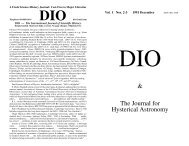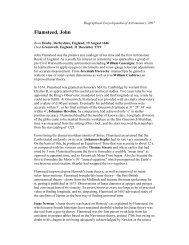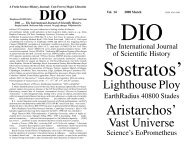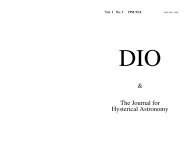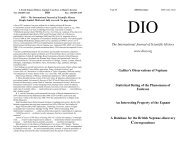DIO 1.2 - DIO, The International Journal of Scientific History
DIO 1.2 - DIO, The International Journal of Scientific History
DIO 1.2 - DIO, The International Journal of Scientific History
You also want an ePaper? Increase the reach of your titles
YUMPU automatically turns print PDFs into web optimized ePapers that Google loves.
160 1991 December <strong>DIO</strong> 1.3 ‡9<br />
mistake for the real scientists <strong>of</strong> antiquity. I should add that the import <strong>of</strong> heliocentrism<br />
in serious ancient astronomy has, from the outset (1976), been a theme 246 <strong>of</strong> DR’s studies<br />
in this area. <strong>The</strong> idea <strong>of</strong> heliocentrists’ rôle in 3 rd century BC astronomy (establishing a<br />
tradition that carried down through Seleukos the Chaldaean 247 and into eastern astronomy)<br />
was earlier broached by van der Waerden 1970 (whose proposals were attacked in Isis, with<br />
classic Muffia surety & haughtiness, by Swerdlow 1973: see Rawlins 1991H fns 6 & 36).<br />
So the following surprise developments (eq. 23 & eq. 24) represent a remarkable — and<br />
wholly novel — double-success for this Muffia-resented, flagrantly whiggist viewpoint.<br />
O2 We know that the Poseidonios school’s distance 248 to the Sun was 10,000 Earth-radii,<br />
or:<br />
r S = 10, 000 e (21)<br />
So, suppose heliocentrists such as Aristarchos scaled the universe (perhaps very much<br />
the way moderns use the Astronomical Unit) similarly, using 1000 units (not necessarily<br />
Earth-radii) = 1000 a for the solar distance:<br />
Astronomical Unit (Sun to Earth distance) = r S = 1000 a (22)<br />
We will call 1 a a milli-AU. Now, the traditional Aristarchan ratio <strong>of</strong> the Sun/Moon distance<br />
(also adopted by the geocentrist tradition: Delambre Histoire de l’Astronomie Ancienne<br />
1817 vol.2 p.207, R.Newton 1977 p.199) is based on the half-Moon being 3 ◦ from quadrature<br />
— i.e., the transverse Earth-Moon line subtends 249 3 ◦ as seen from the Sun. So, if the<br />
Solar System was based on this scale (eq. 22), then in the same milli-AU units, the Moon’s<br />
distance r M will be<br />
r M (trio A) = 1000 a tan 3 ◦ = 52 a 24 ′ = 3144 ′ (23)<br />
This recovers 250 (to a precision <strong>of</strong> ordmag 10 −4 ) the precise Hipparchan number (3144 for<br />
trio A’s e) cited at Almajest 4.11 (§D1, §N10) for the Moon’s distance from the Earth.<br />
O3 A hypothetical Muffioso, secretly reading <strong>DIO</strong>, is now about to (indeed is required<br />
to) protest that the eq. 23 shocker just unveiled: [a] is mere-coincidence (albeit a very long<br />
longshot) and [b] anyway-doesn’t-fit-trio B. So, let’s next unleash the remarkable clincher,<br />
as we now use the same theory to solve also trio B’s superficially discordant Hipparchan<br />
r M . (Compare this classic success, by the fruitfulness criterion <strong>of</strong> fn 85, to the earlier<br />
failures <strong>of</strong> DR, Toomer, & Jones: §D1, §D3, §F4.) One <strong>of</strong> the best known & peskiest<br />
types <strong>of</strong> scribal errors in Greek astronomy & geography is the confusion 251 <strong>of</strong> arcmins with<br />
246 See, e.g., <strong>DIO</strong> 1.1 ‡7 §F3 (from 1976), DR to DSB 1978/5/18, Rawlins 1984A.<br />
247 Neugebauer 1975 pp.610-611, 697-698. In a 1985/4/13 letter to DR, van der Waerden stresses the <strong>of</strong>tenoverlooked<br />
point that the name “Seleukos” is Greek, not Babylonian.<br />
248 Kleomedes 79 (Neugebauer 1975 p.656 eq.16; R.Newton 1977 pp.179&181). [Heath 1913 p.348 suggests an<br />
Archimedean origin.] This figure entails (eq. 33) a solar radius <strong>of</strong> about R S = 44 e , which has the right ordmag.<br />
Another (tenuous) suggestion, <strong>of</strong> high accuracy astronomy here, is the hint <strong>of</strong> ancient use <strong>of</strong> 60 stades/1 ◦ : Neugebauer<br />
1975 p.656.<br />
249 <strong>The</strong> actual Aristarchos Experiment (<strong>DIO</strong> 1.1 ‡7 fnn 5-6) would be most accurately described using sin 3 ◦ ,<br />
not tan 3 ◦ . (See, e.g., Van Helden 1985 p.6 Fig.2.) But the standard ancient lunisolar diagram (ibid p.7 Fig.3 or<br />
Almajest 5.15) draws & computes similar situations using transverse lines shown falsely perpendicular to the Sun-<br />
Earth axis (instead <strong>of</strong> the correct way, e.g., Heath 1913 p.404, Neugebauer 1975 pp.641, 1354 Fig.13), thus effectively<br />
replacing sine with tangent. Swerdlow 1968 p.60 n.30 & Swerdlow 1969 p.293 nn.10-11 both regard as erroneous<br />
(rightly remarking that the difference is trivial anyway) the replacement <strong>of</strong> tangent with sine for the lunar angular<br />
semidiameter in such diagrams (see, e.g., S.Newcomb Compendium <strong>of</strong> Spherical Astronomy 1906 p.158 eq.20), even<br />
though sine is actually the correct choice. Which suggests that eq. 23 is a follower’s version <strong>of</strong> Aristarchos’ scheme,<br />
not the original. (This can be taken as evidence against Aristarchos’ use <strong>of</strong> trig.)<br />
250 <strong>The</strong> mixture here <strong>of</strong> decimal & sexagesimal systems creates no difficulty, since such a hybrid system is used,<br />
e.g., throughout the Almajest. For 3rd century BC Greek celestial distances expressed in simple powers <strong>of</strong> 10, see<br />
Archimedes (“Sandreckoner” pp.226f).<br />
251 <strong>The</strong> least damaging example was the ubiquitous confusion <strong>of</strong> 1 ◦ /8 with 8 ′ . This was virtually an ancient identity:<br />
two examples at §M10 here.<br />
1991 December <strong>DIO</strong> 1.3 ‡9 161<br />
degree-fraction; e.g., Swerdlow 1979 (pp.527-528) savages 252 R.Newton 1973-4 (pp.112-<br />
113) for being misled by just such an error (a longago misreading <strong>of</strong> 344 ◦ 1/12 as 344 ◦ 12 ′ ).<br />
[Neugebauer 1975 p.166 n.3 requires such an ancient scribal error. Same error: ibid p.729<br />
n.15.] Now suppose a member <strong>of</strong> Hipparchos’ school, deputed 253 to calculate r from eclipse<br />
trio B (for which he would need r M for use in eq. 18), started by misreading the eq. 23<br />
distance r M = 52 a 24 ′ as: 52 a 1/24. This would transform distance r M into:<br />
r M (trio B) = 52 a 1/24 = 52 a 02 ′ 1/2 = 3122 ′ 1/2 (24)<br />
Which recovers the Almajest 4.11 trio B value (§D1, §N10) for r M , on the nose.<br />
O4 Note that, without the good luck (for us, anyway) <strong>of</strong> Hipparchos’ computer having<br />
made his fateful scribal slip, the above heliocentrist explanation (§O2) <strong>of</strong> the origin <strong>of</strong><br />
3144 ′ would not be utterly unevadable. Even though true. Fellow explorers will better<br />
empathize with my pleasure at discovering (1991/11/28) the confirmatory scribal miscue,<br />
if they realize that I had already (since 1991/11/9) come upon eq. 23 by theorizing that<br />
Hipparchos was (at this point in his career) drawing his astronomical scale (eq. 22) from real<br />
contemporary astronomers, who were, naturally, heliocentrists. Though I was confident 254<br />
<strong>of</strong> heliocentrist eq. 23 anyway, the moment <strong>of</strong> confirmation — the finding <strong>of</strong> eq. 24 — was<br />
exquisite. I then knew positively that the hypothesis behind eq. 23, namely that heliocentrist<br />
work underlay all high ancient astronomy, was (§D2): “not just a beautiful dream. It was<br />
reality.”<br />
O5 Since scaling the Moon’s distance by the Earth-Sun distance implies realization that<br />
the Sun was the central body for astronomers, the foregoing two astonishing matches (eqs. 23<br />
& 24 vs. §P2) leave no doubt that genuine ancient astronomers: [a] used the Astronomical<br />
Unit, and [b] were heliocentrists. (To scholars <strong>of</strong> scientific history, it should be self-evident<br />
that geocentrism was as nutty to competent ancient scientists as to moderns — a point<br />
demonstrated in detail by “Figleaf Salad”: <strong>DIO</strong> 1.1 ‡7.) While it was perfectly natural<br />
252 Fn 169. To the open & detailed retraction at R.Newton 1977 p.130, Capt.Captious NCSwerdlow responds,<br />
by attempting to portray such refreshing behavior as dishonest! [Note added 1993: Britton 1992 p.xvi repeats<br />
this hilariously inverted slander. As a historical & probably verifiable fact, I can report that (contra Britton’s<br />
unsubstantiated claim <strong>of</strong> “errors scattered throughout Newton’s work” allegedly caused by his use <strong>of</strong> the Halma &<br />
Taliaferro editions <strong>of</strong> the Almajest): R.Newton had both the Manitius & Heiberg editions <strong>of</strong> the Almajest out <strong>of</strong> the<br />
JHU library for years on end. (At the start <strong>of</strong> his researches, RN indeed openly used primarily the Halma edition; but<br />
he henceforth consulted all available versions <strong>of</strong> the text.) Britton loc cit <strong>of</strong>fers the usual Muffia capo gotta-go-now<br />
excuses for not providing “extensive references” to RN’s allegedly copious resultant errors. <strong>The</strong> same Muffia pretense<br />
to apprehension <strong>of</strong> scores <strong>of</strong> serious RN mistakes has been going on for over 20 y : Swerdlow 1979 p.530 says the very<br />
few RN errors he alleges “could be multiplied twentyfold”. DR’s 1979/10/26 letter forcefully challenged NCS to<br />
prove it. NCS instead just repeated himself unquantitatively at HamSwerdlow 1981 p.61, still refusing to substantiate<br />
the big lie. See <strong>DIO</strong> 1.1 ‡5 fn 6; also <strong>DIO</strong> 2.3 ‡8 fn 61, which directly charges that “the Muffia klan has simply been<br />
bluffing in this regard”, especially with respect to its capos’ (unwritten) slanders against DR’s accuracy. But Hist.sci’s<br />
brave & just leadership still hasn’t required that 2 decades <strong>of</strong> Muffia libels be made good.] (Compare Newton’s<br />
frankness to Toomer’s §G2 behavior when upset by the very same problem: altered number-basis.) Thank heavens<br />
for NCS’ alertness. Without the Muffia on guard, why, academe might become corrupt.<br />
253 Given the contrast between eq. 23 & eq. 24 (even accounting for the likelihood that they were produced at<br />
different times for different works: §N3): it is unlikely that the same person performed the lunar calculations leading<br />
to eq. 19 as well as eq. 20. (<strong>The</strong> Muffia also regards the trio A & trio B calculations as well separated events, e.g.,<br />
fn 209.) More revealing: If Hipparchos understood the identity <strong>of</strong> the ultimate basis for both choices <strong>of</strong> r M (eq. 23<br />
& eq. 24), then he could not have innocently published two different versions <strong>of</strong> the exact same amount! (Had the<br />
bungled eq. 24 been published first, we could suppose that eq. 23 was set forth later to quietly correct the r M given.<br />
But it is generally agreed that the reverse was the case: §N3. And trio B not trio A became the basis <strong>of</strong> Hipparchos’<br />
later work: §R1.) So the blunderful disparity, between eqs. 23 & 24, provides unexpectedly strong evidence for some<br />
historically intriguing realizations: [a] Hipparchos headed a stable <strong>of</strong> talent. (None <strong>of</strong> whose names are known to<br />
us. Did a now-anonymous Hipparchos-circle Kepler go on to produce work now glimmering in the fragments we<br />
have <strong>of</strong> Poseidonios’ corpus? Was Poseidonios himself a Hipparchos protégé?) [b] <strong>The</strong> alertness & comprehension<br />
<strong>of</strong> Hipparchos’ editing <strong>of</strong> his computers’ work were about on the order <strong>of</strong> “Editor” Toomer’s when he vetted [Muffia<br />
1990].<br />
254 Nonetheless, in the 1991/11/14 first draft <strong>of</strong> this paper (laserprinted 11/25), DR felt obliged (before finding<br />
eq. 24) conservatively to call eq. 23 speculative. (DR’s attitude in such matters is best gauged from his remarks at<br />
Rawlins 1985G p.255 last sentence, & here at §R10.)



